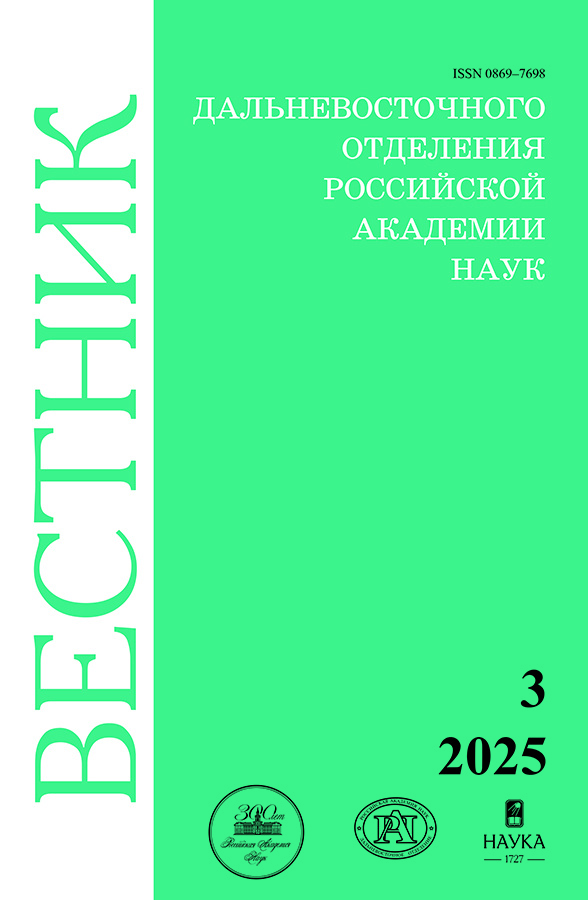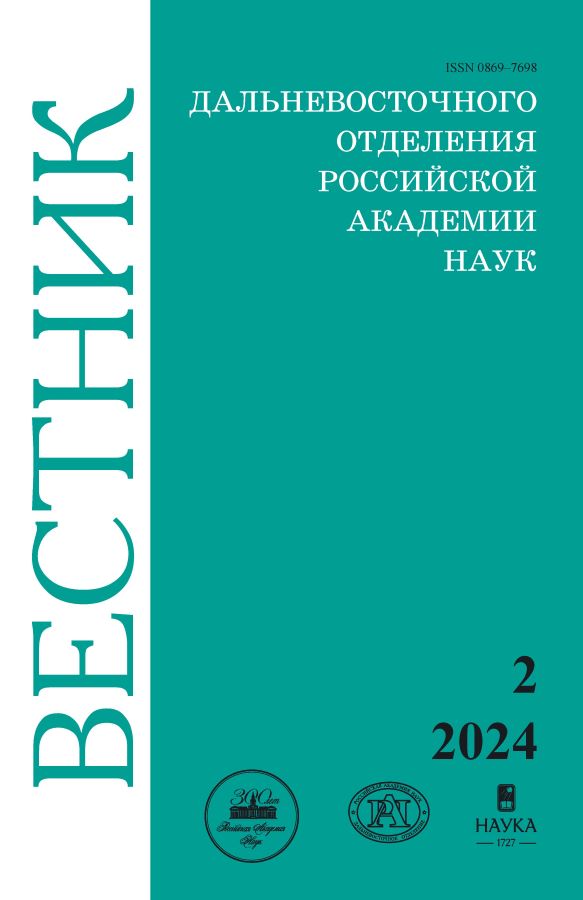Spatial heterogenity of slip on finite faults in the Kuril-Kamchatka Segment of the Pacific subduction zone
- Authors: Konovalov A.V.1, Voronezhtseva E.E.2, Stepnova Y.A.1
-
Affiliations:
- Far East Geological Institute, FEB RAS
- Sakhalin State University
- Issue: No 2 (2024)
- Pages: 17-32
- Section: Earth and Environment Sciences
- URL: https://permmedjournal.ru/0869-7698/article/view/676026
- DOI: https://doi.org/10.31857/S0869769824020025
- EDN: https://elibrary.ru/ldwgvs
- ID: 676026
Cite item
Full Text
Abstract
The study aims at gathering detailed information on source-related seismic radiation patterns in the interaction zone of Pacific and North American lithospheric plates (the Kuril-Kamchatka segment). To achieve our goals, we have developed a program capable of mapping zones of relatively high slip and assessing their area based on GIS data. We have analyzed the asperity distribution on a fault plane. A stochastic model of subduction-related interplate earthquakes has been proposed in the framework of fragmentary-based source model. The obtained results can further be used in a stochastic simulation of a catalogue of finite faults for the Japan-Kuril-Kamchatka island arc.
Keywords
Full Text
About the authors
Alexey V. Konovalov
Far East Geological Institute, FEB RAS
Author for correspondence.
Email: a.konovalov@geophystech.ru
ORCID iD: 0000-0003-2997-1524
Candidate of Sciences in Physics and Mathematics, Leading Researcher
Russian Federation, Yuzhno-SakhalinskEvelina E. Voronezhtseva
Sakhalin State University
Email: evorone@mail.ru
Student
Russian Federation, Yuzhno-SakhalinskYulia A. Stepnova
Far East Geological Institute, FEB RAS
Email: stepnova@fegi.ru
ORCID iD: 0000-0001-5263-5161
Candidate of Sciences in Geology and Mineralogy, Senior Researcher
Russian Federation, VladivostokReferences
- Cienfuegos R., Catalán P. A., Urrutia A., Benavente R., Aránguiz R., González G. What can we do to forecast tsunami hazards in the near field given large epistemic uncertainty in rapid seismic source inversions. Geophysical Research Letters. 2018;45:1–12. doi: 10.1029/2018GL076998.
- Davies G. Tsunami variability from uncalibrated stochastic earthquake models: tests against deep ocean observations 2006–2016. Geophysical Journal International. 2019;218(3):1939–1960. doi: 10.1093/gji/ggz260.
- Somerville P., Irikura K., Graves R. et al. Characterizing crustal earthquake slip models for the prediction of strong ground motion. Seismological Research Letters. 1999;70(1):59–80.
- Mai P. M., Beroza G. C. A spatial random field model to characterize complexity in earthquake slip. Journal of Geophysical Research, Solid Earth. 2002;107(11): ESE-10. doi: 10.1029/2001JB000588.
- Goda K., Petrone C., de Risi R., Rossetto T. Stochastic coupled simulation of strong motion and tsunami for the 2011 Tohoku, Japan earthquake. Stochastic Environmental Research and Risk Assessment. 2017;31:2337–2355. doi: 10.1007/s00477–016–1352–1.
- Crempien J. G.F., Urrutia A., Benavente R., Cienfuegos R. Effects of earthquake spatial slip correlation on variability of tsunami potential energy and intensities. Scientific Reports. 2020;10. 8399. doi: 10.1038/s41598-020-65412-3.
- Tang Y. An Updated Corner-Frequency Model for Stochastic Finite-Fault Ground-Motion Simulation. Bulletin of the Seismological Society of America. 2022;112:921–938. doi: 10.1785/0120210205.
- Sepúlveda I., Liu P. L.-F., Grigoriu M., Pritchard M. Tsunami hazard assessments with consideration of uncertain earthquake slip distribution and location. Journal of Geophysical Research, Solid Earth. 2017;122:7252–7271. DOI: 10.1002/ 2017JB014430.
- Mulia I. E., Ishibe T., Satake K. et al. Regional probabilistic tsunami hazard assessment associated with active faults along the eastern margin of the Sea of Japan. Earth Planets Space. 2020;72. 123. doi: 10.1186/s40623-020-01256-5.
- Irikura K., Miyake H. Recipe for predicting strong ground motion from crustal earthquake scenarios. Pure and Applied Geophysics. 2011;168(1/2):85–104. doi: 10.1007/s00024–010–0150–9.
- Nakahara H. Seismogram envelope inversion for high-frequency seismic energy radiation from moderate-to-large earthquakes. Advances in Geophysics. 2008;50:401–426.
- Gusev A.A Stochastic simulation of extended earthquake source for application in seismic hazard estimation. 1. Basics and general structure of the algorithm. Problems of Engineering Seismology. 2013;(1):5–18.
- Martinez Alcala K. Stochastic Source Modelling and Tsunami Analysis of the 2012 Mw 7.8 Haida Gwaii Earthquake. Electronic Thesis and Dissertation Repository. 2021. 8145. URL: https://ir.lib.uwo.ca/etd/8145 (data of access: 31.05.2023).
- Gusev A. A., Pavlov V. M., Guseva E. M. Stochastic simulation of extended earthquake source for application in seismic hazard estimation. 3. Methods of analysis of uncertainty and practical testing of the procedure. Problems of Engineering Seismology. 2014;(1):39–56.
- Nicknam A., Eftekhari S. N., Yazdani A. Estimation of near fault ground motion based on a hybrid source model and a theoretical Green’s function method. Journal of Vibroengineering. 2015;17:357–368.
- Gusev A. A. Multiasperity fault model and the nature of short-period subsources. Pure and Applied Geophysics. 1989;130:635–660. doi: 10.1007/BF00881602.
- National Earthquake Information Center of United States Geological Survey. URL: https://earthquake.usgs.gov/ (data of access: 31.05.2023).
- Earthquake Source Model Database. URL: http://equake-rc.info/srcmod/ (data of access: 31.05.2023).
- National Earthquake Information Center of United States Geological Survey. URL: https://earthquake.usgs.gov/earthquakes/eventpage/official20110311054624120_30/executive (data of access: 31.05.2023).
- Safonov D. A., Konovalov A. V., Zlobin T. K. The Urup earthquake sequence of 2012–2013. Journal of Volcanology and Seismology. 2015;9(6):402–411. doi: 10.1134/S074204631506007X.
- Morikawa N., Fujiwara H. A new ground motion prediction equation for Japan applicable up to M9 mega-earthquake. Journal of Disaster Research. 2013;8(5):878–888.
- Lee Y. T., Ma K. F., Hsieh M. C., Yen Y. T., Sun Y. S. Synthetic ground-motion simulation using a spatial stochastic model with slip self-similarity: Toward near-source ground-motion validation. Terrestrial, Atmospheric and Oceanic Sciences. 2016;27:397–405. doi: 10.3319/TAO.2015.11.27.01(TEM).
- Kozhurin A. Active faults in Sakhalin and North of the Sea of Okhotsk: Does the Okhotsk plate really exist? Journal of Asian Earth Sciences. 2022;230. 105219. doi: 10.1016/j.jseaes.2022.105219.
- Ground motion simulation based on fault rupture modelling for seismic hazard assessment in site evaluation for nuclear installations. Vienna: International Atomic Energy Agency; 2015. (Safety reports series, ISSN1020–6450; N85).
- Kumar K., Thingbaijam S., Mai P. M., Goda K. New empirical earthquake source-scaling laws. Bulletin of the Seismological Society of America. 2017;107(5):2225–2246.
- Takahashi H., Kasahara M. J. Spatial relationship between interseismic seismicity, coseismic asperities and aftershock activity in the Southwestern Kuril Islands. In: Volcanism and Subduction: The Kamchatka Region; 2007. P. 153–164. doi: 10.1029/172GM14.
- Yamanaka Y., Kikuchi M. Asperity map along the subduction zone in northeastern Japan inferred from regional seismic data. Journal of Geophysical Research. 2004;109. B07307. doi: 10.1029/2003JB002683.
- Hayes G. P., Moore G. L., Portner D. E., Hearne M., Flamme H., Furtney M., Smoczyk G. M. Slab2, a comprehensive subduction zone geometry model. Science. 2018;362:58–61. doi: 10.1126/science.aat4723.
- Information resource. URL: https://github.com/usgs/slab2 (data of access: 31.05.2023).
Supplementary files











